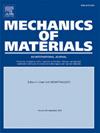Criteria for mode shape tracking in Micropolar-Cosserat periodic panels
IF 3.4
3区 材料科学
Q2 MATERIALS SCIENCE, MULTIDISCIPLINARY
引用次数: 0
Abstract
This study communicates the dispersion nature and motion of propagating waves on the periodic panels resulting from the variation of the Micropolar-Cosserat (MC) parameters such as characteristic length-scale and Cosserat shear modulus. The non-dimensionalization of the system determines the independent parameters for the MC beam model in order to examine the motion of the micro-rotational as well as flexural wave modes. A periodic boundary condition based on Bloch-Floquet’s theorem is employed on the unit cell to maintain the periodicity and assess the eigenvalue domain within the transfer matrix approach. A significant part of this enlightening theoretical comprehension regarding veering, locking, and coupling is elucidated by tracking the mode shapes within the Modal Assurance Criteria (MAC), which is the prime novelty of this research. Periodically pass-band and partial bandwidth are also examined to build up confidence concerning the complex and real wave modes, respectively. A slight variation of MC parameters can dramatically alter the emergence of veering, locking, and coupling phenomena, even 1% only. The band gap (BG) calculated through the two-dimensional (2-D) Finite Element Analysis (FEM) corroborates well with the reduced one-dimensional (1-D) MC periodic panels.
Micropolar-Cosserat周期板模态振型跟踪准则
本研究揭示了由微极-Cosserat (MC)参数(如特征长度尺度和Cosserat剪切模量)的变化引起的周期板上传播波的色散性质和运动。系统的无量纲化决定了MC梁模型的独立参数,以便研究微旋转和弯曲波模式的运动。基于Bloch-Floquet定理的周期边界条件被应用于单元胞上,以保持传递矩阵方法的周期性并评估其特征值域。通过跟踪模态保证标准(MAC)内的模态振型,阐明了这一关于转向、锁定和耦合的启发性理论理解的重要部分,这是本研究的主要新颖之处。周期性通频带和部分带宽也分别进行了检查,以建立对复波和实波模式的置信度。MC参数的微小变化可以显著改变转向、锁定和耦合现象的出现,即使只有1%。二维(2-D)有限元分析(FEM)计算的带隙(BG)与简化的一维(1-D) MC周期板相吻合。
本文章由计算机程序翻译,如有差异,请以英文原文为准。
求助全文
约1分钟内获得全文
求助全文
来源期刊

Mechanics of Materials
工程技术-材料科学:综合
CiteScore
7.60
自引率
5.10%
发文量
243
审稿时长
46 days
期刊介绍:
Mechanics of Materials is a forum for original scientific research on the flow, fracture, and general constitutive behavior of geophysical, geotechnical and technological materials, with balanced coverage of advanced technological and natural materials, with balanced coverage of theoretical, experimental, and field investigations. Of special concern are macroscopic predictions based on microscopic models, identification of microscopic structures from limited overall macroscopic data, experimental and field results that lead to fundamental understanding of the behavior of materials, and coordinated experimental and analytical investigations that culminate in theories with predictive quality.
 求助内容:
求助内容: 应助结果提醒方式:
应助结果提醒方式:


